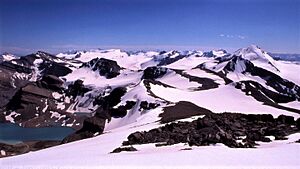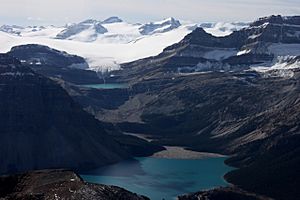Wapta Icefield facts for kids
The Wapta Icefield is a huge sheet of ice high up in the Canadian Rockies. It sits right on the Continental Divide of the Americas, which is like a giant line that separates rivers flowing to different oceans. This amazing icefield is found in both British Columbia and Alberta, inside two beautiful places: Banff National Park and Yoho National Park.
Many glaciers flow out from the Wapta Icefield, like icy rivers. Some of these are the Vulture, Bow, and Peyto Glacier. The melting ice from these glaciers helps fill important rivers, such as the Kicking Horse and Bow River, as well as many streams and lakes in the area.
Scientists study the Wapta Icefield a lot. They have found that this big icefield is getting smaller. The glaciers that flow from it are shrinking, especially at their lower parts. For example, the Peyto Glacier has become both shorter and thinner over time. Back in the 1980s, the icefield covered about 80 square kilometers (31 square miles).
Adventurers and mountaineers can visit the Wapta Icefield easily in both summer and winter. Many people enjoy ski trips across the icefield in winter or go glacier hiking in summer. Sometimes, they even combine a trip across the Wapta Icefield with a visit to the Waputik Icefield, which is just to the south.
What Glaciers are Part of Wapta?
The Wapta Icefield is like a parent to several important glaciers. These glaciers flow out from the main icefield.
- Peyto Glacier
- Bow Glacier
- Yoho Glacier
- Vulture Glacier
The Crowfoot Glacier used to be connected to the Wapta Icefield, but it has now separated and is no longer part of it.
Huts for Adventurers
For mountaineers and hikers exploring the Wapta Icefield, there are five special huts. These huts provide a safe place to stay overnight. The Alpine Club of Canada manages these huts.
- Bow Hut
- Peter and Catharine Whyte Hut (Peyto Hut)
- Balfour Hut
- Louise and Richard Guy Hut
- Scott Duncan Hut
Images for kids



